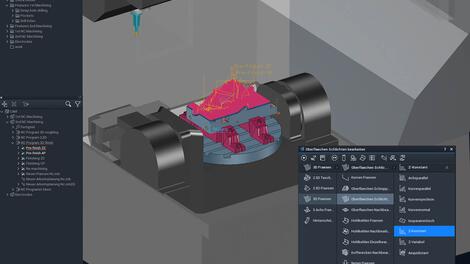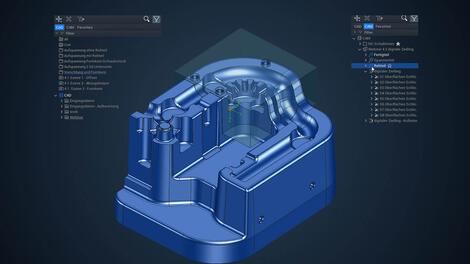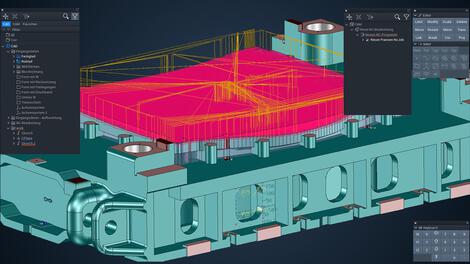Rethinking CAM
Interview with Dr. Wolfgang Schinke, Head of Development for CAM technologies
Version 4.1 has much more to offer than just a parametric/associative solid kernel. We’re therefore devoting the third interview in our series entirely to the subject of CAM. What you’ll learn:
- Why simple user guidance is so important
- How Tebis provides a better overview with clear structures
- Why CAD and CAM belong together
- Why CAM programming with the Job Manager is so easy
- How Tebis is paving the way for custom-configurable software
- How the "Browser Touch" supports communication with your business partners
- Why user guidance isn’t everything; the "how" of manufacturing is also important
- Why the software lays the foundation for all future automation processes



Why simple user guidance is so important
Faster personnel training and greater process reliability
Dr. Schinke, the new version 4.1 places a lot of emphasis on clear, simple and intuitive user guidance. Would you say that the user experience in modern software solutions is just as important as their functionality?
I’d say that one can’t be viewed separately from the other. Companies in the manufacturing industry have to be able to quickly and efficiently manufacture parts, from simple to complex. To do that, they need a modern end-to-end software solution that provides them with all the necessary functions – from CAD to CAM to MES. But the user guidance also plays a key role.
Based on the motto "The eye follows the design and programming?"
That's one way to put it. It's simply more fun to work with an application that's visually appealing and easy to use. But even more important are the effects of user guidance on the company's overall cost-effectiveness.
Meaning?
First of all, it costs valuable time if users have to spend a long time searching for hidden functions or have to deal with less than logical user guidance. When you consider all the designers and CAM users out there, this adds up to a lot of time. It also affects process reliability. Second, in times when there’s a shortage of qualified personnel and large order fluctuations, it’s extremely important that new personnel are "brought on board" quickly and integrated in existing work processes. There can't be any long learning curves. Third, the software can contribute significantly to supporting users in their daily decision-making process in an increasingly complex work world. It must be possible to automate work steps.
Clear structures for designers and CAM programmers
Modern, practical and user-oriented
Let's get to the details. What’s Tebis doing to make operation of the software as simple as possible for the user?
We’re in continuous contact with our key users and ask them what they think makes for a modern, practical and user-oriented user guidance. Users and developers are in constant dialog. In addition, external usability experts continuously evaluate our software.
And what’s the result?
Essentially, they want an interface that’s clear, comprehensible and stringently structured. On the one hand, this is very important for the general overview. On the other, designers and CAM programmers must be able to achieve their objectives as quickly as possible. So we wanted to hear from our users about how they typically proceed in design and CAM programming. New users in particular also find their bearings quickest if clear and meaningful terms are used.
The new structure tree
CAD meets CAM
How exactly does Tebis implement this?
Tebis users organize their activities around a structure tree, which we also call an object tree. CAM users also use the Job Manager and Tebis NCJob technology.
Let's take a closer look at these three categories in order: the structure tree, the Job Manager and NCJob technology. The structure tree describes the topmost hierarchical level that CAD designers and CAM programmers in a company can both access?
Yes, that's correct. The most important new feature in Tebis version 4.1 is the parametric/associative solid kernel. Parametric geometries aren’t rigid elements, but rather variable objects. We therefore call the structure tree an "object tree." It’s subdivided into CAD and CAM areas. The CAD node shows the overall design history. It can be traced at any time. The user can access the design status of a part and quickly and easily modify individual objects using parametric/associative methods. Analogously, the CAM node in the tree contains the Job Manager. All manufacturing-related functions can be directly accessed here. NC machining operations and NC sequences are displayed along with their respective input data. The structure tree is closely linked with the user guidance. The handling of CAD and CAM objects is also nearly identical.
CAD and CAM belong close together in Tebis.
Our parametric technology is therefore also made for manufacturing: Solid technology and surface technology are parametrically "married." The CAD data that the CAM programmer uses to create toolpaths are optimized for CAM programming right from the start. Our parametric technology doesn't just address the designer who designs the final part:
It also addresses the CAD designer.
The CAD designer designs the resources needed to manufacture the actual part. And if necessary, he/she also needs to deal with manufacturing preparation. The boundaries are often fluid. Sometimes both CAD and CAM tasks are assigned to one and the same person. Let me express it in this way: CAD needs to be like CAM. With the standardized structure tree, you maintain an overview of all CAD and CAM processes. Our guiding principle was: How can the user reach the information they need with the fewest possible clicks? Of course, the CAD and CAM areas can be displayed, configured and hidden independently.
The Job Manager
The heart of CAM programming
Now we come to the Job Manager:
My favorite subject! The Job Manager is essentially the heart of our software. A part is manufactured in the shop in a very specific way. We map this process in exactly the same way in the Job Manager. CAM programmers use it to create and manage all of the NC programs needed to manufacture a part. It’s always available and can be directly viewed, checked and also modified. Parameters can be changed with no need to call up additional functions. The Job Manager and our NCJob technology are closely interrelated.
And what exactly is it that makes the Tebis Job Manager and NCJob technology so intuitive and user-friendly?
For example, if you create a new NCJob, all possible selection options are prefiltered for you. What exactly does that mean? First, you select the technology. For example, you simply specify if you want to drill, mill or turn. Let's assume you want to mill. In this case, you’re offered a selection list with all of the available machining types for milling – from 2.5D milling and pocket milling to 3D milling, 5-axis milling and undercut milling. If you decide on 5-axis milling, you see all the functions you can use to perform 5-axis milling. If you now select the desired function – for example "Surface roughing" – you can select the required roughing strategy in the next step, from axis-parallel to adaptive roughing.
So the parameters can be configured right in the input dialog?
Yes. Only the parameters that you need for a specific task are visible in each input dialog – no more and no less. This not only simplifies operation, it also improves process reliability.
And how do you select machines or tools?
The selection of the machine, the blank, the machining geometry and the tools build on each other. The overall structure is realistically based on the logical methods used by the CAM programmer.
Job Manager and NCJob technology
The entire processing of a part is hierarchically structured in the Tebis Job Manager.
Level 1: All NC programs that can be executed in a single setup are summarized in an NC machining operation.
Level 2: The NC program forms the next level in the hierarchy. NC programs contain NCJobs to be processed and determine the processing sequence of the NCJobs in the NC program.
Level 3: Finally, the lowest level in the hierarchy consists of the actual NCJob. It contains all the parameters needed for calculating a toolpath.
This structure enables automated NC programming and also enables users to react flexibly to changes in requirements.
Greater flexibility
On the path to custom-configurable software
Can we have a quick overview?
All relevant information – down to optimization of the paths and connections – is clearly summarized in a list. You can see everything at a glance and can always see the machine run time, machining time and the status of the toolpath, amont other things.
So can everyone see everything?
In the future, everyone should be able to configure their own views. We’re systematically expanding these options. We’re planning to let everyone essentially create their own software to precisely meet their needs.
Browser Touch
Communications interface
Are you also continuing to offer the free Tebis browser? It’s very helpful for acquiring an initial overview of the geometric properties of a CAD model.
And not only that. Our customers often use the browser as a visual reference when discussing the CAD model with their business partners. The Browser 4.1 can now be easily and intuitively operated by touch. Centering the part, setting a fixed point, selecting views and other actions can now be performed on a tablet. With the browser, you can now essentially exchange visual information on a CAD model at any time and any place.
The "how" of manufacturing
NC template technology
Dr. Schinke, we've talked a lot about "simplicity" and "process reliability." But even if the software itself is easy to use, the user still has to know exactly what they’re doing and how to configure the specific parameters. The user guidance doesn't mean that they don’t need this knowledge about the "how" of the manufacturing.
No, not the user guidance alone. Our current manufacturing world is so complex that even the most experienced employee is no longer able to quickly decide what tool, what machine, what technology and what machining strategy is most appropriate for a specific manufacturing task. As I already mentioned: Modern CAD/CAM software therefore needs to be able to support the user in his/her daily decision-making process.
You mentioned standardized templates and automated CAD/CAM processes.
Standardized templates are a very important element, but they’re not the only element in automated will manufacturing processes. By the way, I'm not talking about templates that are equally valid for all companies. I'm talking about templates that map the manufacturing knowledge of your specific company. This manufacturing knowledge is based on your own employees’ many years of experience. With a logical user interface and appropriate templates, your employees can react creatively and innovatively to new or changing requirements, because they’re no longer confronted with tedious basic problems.
The software as the foundation of automation processes
Everything fits together
What still plays an important role in automating manufacturing processes?
Digitalized processes and MES are closely involved. Because you also have to plan logically and map these processes in the virtual world. All of these elements interact together. How everything interacts depends in turn on your array of parts and on resources like tools and machine tools. My colleague Reiner Schmid can tell you more about automation, programming with digital twins and digitalized processes. At this point, I want to say this: We’re paving the way to the future with version 4.1. Because the software lays the foundation for all future automation processes.


